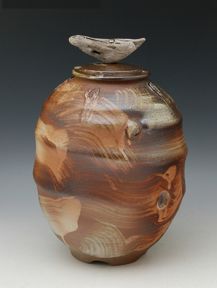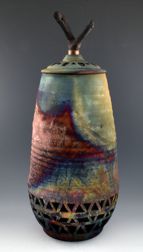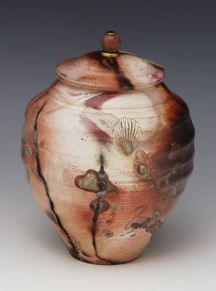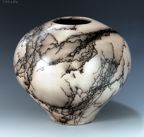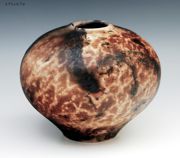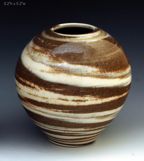 NERIAGE AND NERIKOMI AND MISHIMA AND OTHER HIGH FIRED TECHNIQUES NERIAGE - Neri is a root word meaning "to mix" and age is a root word meaning to "pull up." This refers to the pulling up action in throwing clay on a wheel, hence neriage refers to wheel work with colored clays. Functional, water tight.
NERIKOMI - Komi means "to press into," as in pressing clay slabs into a mold. Nerikomi thus means hand-building with colored clay, which in Japan I guess usually meant mold work. It has been expanded to include other methods of hand-building." Neriage and nerikomi both use either naturally occurring colored clays or light-colored clays that are specifically stained to satisfy the artist's color requirement. Neriage, or agateware, is done by laminating different colored clays together and throwing them on a wheel to develop a swirling and spiraling blend of the clays. Objects made this way can be left with the swirl pattern, or altered by various forms of cutting the surface, with fluting and faceting. Balls of laminated clays are best left covered in a plastic sheet so amelioration can take place. Cutting across the grain of laminated clays will expose an infinite variety of random patterns. The type of pattern can be controlled both by the thickness of the layers and by how the laminations are placed when thrown on the wheel. If they are vertical to the wheel head, they likely will produce fine, lacy patterns. If they are placed horizontally, much bolder patterns can be expected. If placed diagonally, a combination of both bold and lacy patterns might be expected.
This example has both Neriage and Mishima work. Functional, water tight.
WOOD FIRED VESSELS WFV (wood fired vessels) In the case of wood-firing, the ware is painted by flames and fly ash (ash particles resulting from the burning of the wood). Once the kiln becomes very hot, the fly ash from the firebox that flies around the kiln and deposits on the pieces melts and alters glazes as well as forming a natural ash glaze and random flashing and color. It takes over a week to complete a firing. Unlike Raku or smoked works, wood fired vessels are high fired and watertight and functional. This is a link to the process. Functional, water tight. https://www.youtube.com/watch?v=euGKzjQVXBA
|
||||||
|
Western Primitive firing techniques THE FOLLOWING INFORMATION REFERS TO SMOKE FIRED AND PRIMITIVE TECHNIQUES RAKU FIRING This rapid spontaneous method of glazing and firing was created in Japan in the 16th century. Although traditional Raku glazes are soft and subdued contemporary Raku potters use a variety of surfaces and glazes in a wide color range, including metallic luster. In American or western Raku, the piece is fired and then immersed in combustible material such as: wood chips, leaves, hay etc. The chamber is then covered. The resulting oxygen reduction atmosphere turns the unglazed clay black. The pot is then removed and cooled. Sometimes the work plunged into cold water for quick cooling. The word "Raku" means "felicity or happiness". In Japanese Raku, the work is quickly fired and removed from the kiln still white hot. It is then usually placed on a stone or the ground to cool. Very coarse clay is used and the unglazed clay areas are usually black, red brown or white. Traditionally the pieces fired in this way were used in great part, for the Zen tea ceremony. In order to withstand the thermal shock of this rapid heating and cooling process, sand or grog (ground fired clay) is mixed with the clay making it very porous, delicate and unsuitable for liquids or food. The pieces created from this process are strictly aesthetic statements. Firing in this manner leads to exciting and variable results. Copper mattes especially will tend to loose some of the bright color over the years, changing slightly until they acquire a patina similar to traditional Raku glazes (oriental) soft and subdued...They are like living things. They mellow and age gracefully if taken proper care of. They should not be placed in direct sunlight and the surface should only be cleaned with a soft brush. Understanding the process and how the pottery ages will add to your appreciation of contemporary Raku work. Glazes, after all, are only part of the statement. The craftsmanship, form, balance, proportion, surface and composition as well as color make the entire piece work. Non-functional decorative or dry storage use only |
||||||
Sagger, Pit, smoking and other alternative and primitive techniques. These techniques often confused with Raku firing usually have no glaze applied but rely on surface treatment and the fire to give them color and texture. SAGGER FIRED, PIT FIRED, HORSE HAIR AND NAKED RAKU VESSELS have no glaze on the surface of the piece. These pieces are created either on the wheel or in traditional ways, i.e. hand building: coils or pinching. As in ancient times, some of this work is painstakingly burnished by hand with a smooth stone or piece of metal. The process is one of intense labor. For burnished (polished work) when close to the dry state the piece is polished with a smooth stone, or piece of metal. This is done several times being careful not to damage or finger print the surface. When the piece is completely dry, It is completed using one of more of the following techniques: click HERE for printable PDF Document on sagger firing
The information below referees to the origins of the word Raku and its traditional Japanese associations.
|

 MISHIMA
-
MISHIMA
- 